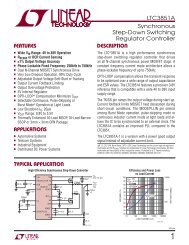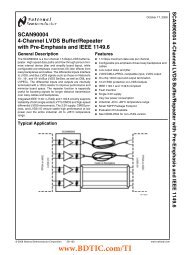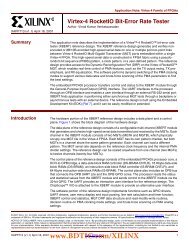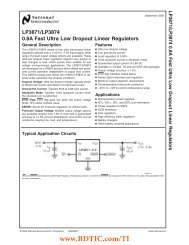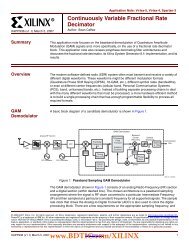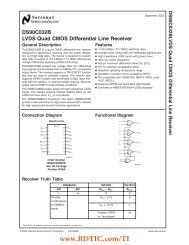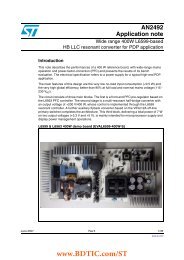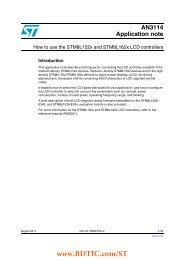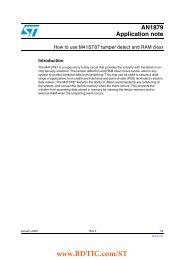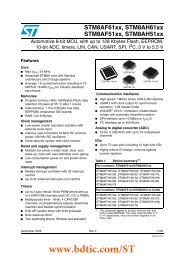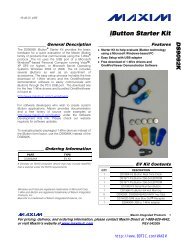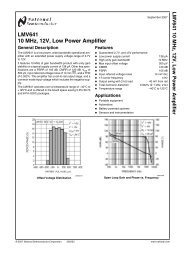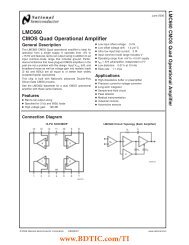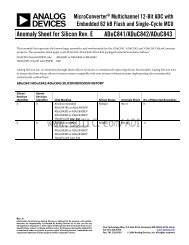Audio Codec with USB Interface, Mono ... - Texas Instruments
Audio Codec with USB Interface, Mono ... - Texas Instruments
Audio Codec with USB Interface, Mono ... - Texas Instruments
You also want an ePaper? Increase the reach of your titles
YUMPU automatically turns print PDFs into web optimized ePapers that Google loves.
Endpoints<br />
Internal Regulator<br />
Clock and Reset<br />
DAC<br />
ADC<br />
Microphone Bias<br />
PCM2912A<br />
www.ti.com.......................................................................................................................................................................................... SLES230–SEPTEMBER 2008<br />
The PCM2912A has the following three endpoints:<br />
• Control endpoint (EP #0)<br />
• Isochronous out audio data stream endpoint (EP #1)<br />
• Isochronous in audio data stream endpoint (EP #2)<br />
The control endpoint is the default endpoint. The control endpoint controls all functions of the PCM2912A by the<br />
standard <strong>USB</strong> request and <strong>USB</strong> audio class-specific request from the host. The isochronous out audio data<br />
stream endpoint is an audio sink endpoint, which receives the PCM audio data. The isochronous out audio data<br />
stream endpoint accepts the asynchronous transfer mode. The isochronous in audio data stream endpoint is an<br />
audio source endpoint, which transmits the PCM audio data. The isochronous in audio data stream endpoint<br />
uses synchronous transfer mode.<br />
All required power sources are generated by five internal regulators.<br />
Each regulator generates 3.3 V (typical, <strong>with</strong>out load) from V BUS (pin 2). Each regulator has an output pin and a<br />
ground return pin (as described in Table 6); this pair must be decoupled <strong>with</strong> an appropriate capacitor. Note that<br />
this capacitance affects inrush-current limitation. One band-gap reference circuit supplies reference voltage for all<br />
regulators. BGND (pin 1) is provided for reference ground of the band-gap reference.<br />
Table 6. Internal Regulator Summary<br />
SUPPLIED CIRCUIT OUTPUT RETURN<br />
Digital V DD (pin 5) DGND (pin 6)<br />
Analog V CCA (pin 15) AGND (pin 13)<br />
Headphone (L-ch) V CCL (pin 19) HGND (pin 20)<br />
Headphone (R-ch) V CCR (pin 21) HGND (pin 20)<br />
PLL V CCP (pin 26) PGND (pin 25)<br />
The PCM2912A requires a 6-MHz (±500 ppm) clock for <strong>USB</strong> function and audio function, which can be<br />
generated from a built-in crystal oscillator <strong>with</strong> a 6-MHz crystal resonator. The 6-MHz crystal resonator must be<br />
connected to XTI (pin 8) and XTO (pin 7) <strong>with</strong> one high (1-MΩ) resistor and two small capacitors, whose<br />
capacitance depends on the load capacitance of the crystal resonator. An external clock can be supplied through<br />
XTI; if an external clock is supplied, XTO must be left open. Because there is no clock disabling signal, using the<br />
external clock supply is not recommended. SSPND (pin 29) is unable to use clock disabling.<br />
The PCM2912A has an internal power-on-reset circuit, which works automatically when V BUS (pin 2) exceeds 2.5<br />
V, typical (2.2 V to 2.7 V), and approximately 700 μs is required until the internal reset is released.<br />
The PCM2912A has a stereo delta-sigma DAC that uses a 64-f S oversampling technique <strong>with</strong> an 8-f S<br />
oversampling digital filter. DAC outputs are provided through the headphone amplifier; V OUTL (pin 18) and V OUTR<br />
(pin 22) provide 13 mW at 32 Ω and 0.6 V CCL/V CCR V PP at a 10-kΩ load.<br />
The PCM2912A has a mono delta-sigma ADC that uses a 64-f S oversampling technique <strong>with</strong> a 1/64-f S<br />
decimation digital filter. The microphone input, V IN (pin 16), is fed to the ADC through a +20-dB microphone<br />
amplifier and the PGA, which has +30 dB to –12 dB in 1-dB steps.<br />
The PCM2912A has a microphone bias generator, which provides a low-noise, 0.75-V CCA, 2-mA source current<br />
output <strong>with</strong> appropriate output impedance for electret-microphone driving. This output, MBIAS (pin 17), should be<br />
bypassed to AGND (pin 13) through an appropriate capacitor to reduce the output noise level.<br />
Copyright © 2008, <strong>Texas</strong> <strong>Instruments</strong> Incorporated Submit Documentation Feedback 21<br />
Product Folder Link(s): PCM2912A



